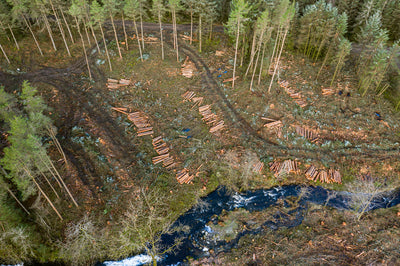How Does Deforestation Impact Water Quality?
RSS
Analies Dyjak, M.A. & Christina Liu, B.S., M.B.A.
Globally, we have lost one-third of the world’s forests, or 2 billion hectares (an area twice the size of the United States). More often than not, humans are responsible for deforestation. The land that surrounds a body of water plays a critical role in water quality and availability. Forested land not only acts as a “natural filter” for incoming water, but also reduces the risk of flooding.
What Is Deforestation?
Forested areas are cleared to make way for agriculture, commercial buildings, homes, and other large scale construction projects. Deforestation results in significant changes to the surrounding and global ecosystems, and habitat loss can lead to species extinction. The most extreme examples of this include the Amazon Rainforest, which has shrunk 18% in the last 40 years. Illegal mining, illegal logging, agricultural expansion, lack of government control, and climate change have all contributed to deforestation in the Amazon.
Deforestation has lesser-known secondary consequences that are becoming a focal point for scientists. Trees absorb carbon dioxide and release oxygen back into the environment. Without trees, the carbon accumulates in the atmosphere which contributes to rising global temperatures.
How Does Deforestation Impact Drinking Water Supplies?
Reduction in Rainfall and Global Implications:
Forests help control the water cycle by regulating rainfall and evaporation. The layers of the forest canopy, branches, and roots store and release water vapor, which helps to control rainfall. Forests also help reduce the impacts from flooding by blocking and slowing down the flow of runoff from storms. Deforestation, however, weakens this process, leading to irregular rainfall, including drought and flooding.
Also, while deforestation may occur locally, its effects are global. For example, in a 2005 study, deforestation of Central Africa caused a decrease in precipitation of about 5%–15% in the Great Lakes region, mostly centered in Illinois, with a peak decrease of about 35% in February. In addition, a 25% decrease in rainfall in Texas was attributed to Amazon deforestation. While the three major forest basins do not respond the same, deforestation in other areas have also been observed to cause changes in rainfall and the water cycle elsewhere in the world. The decrease in rainfall combined with the increase in water usage across the United States are contributing to severe drought and aridification throughout many states.
Increased Erosion and Runoff:
Forested land does a lot of the “heavy lifting” in terms of filtration. Soil absorbs pollutants and helps to slow the rate of flowing water. The tree roots also anchor soil against erosion, which reduces runoff, and lowers downstream water treatment costs. When forests are disturbed and degraded, (from deforestation or wildfires or a combination of the two), sediment flows into streams and pollutes water.
Reduced Water Quality/Access to Drinkable Water:
Scientists conducted a study in Malawi on deforestation and water quality. They found that when deforestation increased 1%, it was equivalent to a nearly 1% decrease in access to clean water, which was equivalent to a decrease in rainfall of nearly 10%. They also observed that access to source water did not mean people had more drinkable water. Deforestation increases soil erosion, resulting in higher soil, sediment, and turbidity levels in the water, increasing the need for drinking water treatment.




